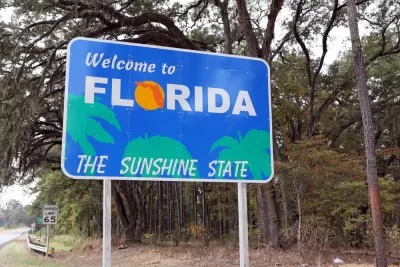Data released by the U.S. Census Bureau showed New York with an estimated population of 19.5 million people as of July 1, 2019, making it the fourth largest state in the country, but also showed that New York’s population dropped.

Two of Schenectady County's state legislators, Senator Jim Tedisco (R,C,I,REF-Glenville) and Assemblyman Angelo Santabarbara (D-Rotterdam), launched a bi-partisan to investigate the Empire State's population loss for the fourth consecutive year. Only four states have grown more slowly since 2010.
"The latest data recently released by the U.S. Census Bureau showed New York with an estimated population of 19.5 million people as of July 1, 2019, making it the fourth-largest state in the country, but also showed that New York’s population dropped 76,790 over the previous year," notes Tedisco's Jan. 30 press release (source article).
Although the numbers are up an estimated 75,000 over the [2010] Census, the loss was the fourth straight year for New York’s population. “It means New York lost more people than any other state in the nation for the second year in a row in 2019, according to the new federal estimates,” Santabarbara said.
New York's numeric population loss was by far the greatest from July 1, 2018, to July 1, 2019. In second place was Illinois with just over 51,000 people. Only West Virginia and Alaska had a higher percentage of losses.
Since 2010, New York lost a net total of about 1.4 million residents to other states, more than any other state in the country, according to the analysis by the Empire Center [an independent, non-partisan, non-profit think tank based in Albany, New York].
It also means that the state will likely lose a Congressional seat after the 2020 Census, one of 10 mostly Northeastern and Midwestern states projected to do so, according to a recent analysis.
The Empire State analysis found that New York had a growth rate of just 0.4 percent since 2010, ranking 46th out of 50 states and the District of Columbia. While immigration was a positive number, it didn't make up for the negative net domestic migration.
New York gained 45,753 foreign immigrants over the previous year—the lowest annual immigrant total since 2010, and the second lowest in at least 58 years. The result was a net migration loss of 134,896 people—the second largest since 1980.
Who's leaving?
The 2019 [Empire Center] report [pdf] found that the largest share of people that left New York State are middle class workers and high income earners. According to United Van Lines, those who left New York earned more than $150,000 and only 8.4 percent earned less than $50,000.
Where are they headed?
According to the center's research director, E.J. McMahon, "Florida has been the leading destination for New York out-migrants, accounting for 21.3 percent of the net total (calculated as out-migrants minus in-migrants) during the seven-year period [from 2011-2018]." The only other state to score in double digits was New Jersey with 15.5 percent, though it should be pointed out that the Garden State also lost population last year, but by the lowest percentage among the ten states thaw saw populations declines.
What to do about it?
“The elephant in the room that our state government’s not talking about is why New York State is number one for highest population loss in the nation?" said Tedisco.
This is a bi-partisan effort to shine the light on this problem that’s causing people to leave our Upstate communities and to find out why the Empire State is fast becoming the ‘Empty State’ so we can change the agenda to keep them here.”
However, out-migration appears to be more characteristic of downstate than upstate from a numeric perspective, according to an April 2019 Empire Center report that evaluated 2017-2018 census data.
During the 12-month period ending last July 1, the 50 counties of upstate New York lost another 8,719 residents, a decrease of 0.14 percent, while the downstate region (New York City, Long Island and the lower Hudson Valley) lost a combined total of 39,791 people, or 0.30 percent. Virtually all of that decline occurred in New York City, accounting for the bulk of the state’s net population decrease of 48,510 in 2017-18.
Related in Planetizen:
-
States to Gain and Lose Congressional Districts After Census Identified, January 14, 2020
-
2019 Year-End Census Estimate: Slowest Growth in 100 Years, January 5, 2020
-
Sunshine State Overtakes Empire State as Third Most Populous State, January 4, 2015
Hat tip to Mark Boshnack.
FULL STORY: Why are People Leaving New York State?

Trump Administration Could Effectively End Housing Voucher Program
Federal officials are eyeing major cuts to the Section 8 program that helps millions of low-income households pay rent.

Planetizen Federal Action Tracker
A weekly monitor of how Trump’s orders and actions are impacting planners and planning in America.

Ken Jennings Launches Transit Web Series
The Jeopardy champ wants you to ride public transit.

California Invests Additional $5M in Electric School Buses
The state wants to electrify all of its school bus fleets by 2035.

Austin Launches $2M Homelessness Prevention Fund
A new grant program from the city’s Homeless Strategy Office will fund rental assistance and supportive services.

Alabama School Forestry Initiative Brings Trees to Schoolyards
Trees can improve physical and mental health for students and commnity members.
Urban Design for Planners 1: Software Tools
This six-course series explores essential urban design concepts using open source software and equips planners with the tools they need to participate fully in the urban design process.
Planning for Universal Design
Learn the tools for implementing Universal Design in planning regulations.
Ada County Highway District
Clanton & Associates, Inc.
Jessamine County Fiscal Court
Institute for Housing and Urban Development Studies (IHS)
City of Grandview
Harvard GSD Executive Education
Toledo-Lucas County Plan Commissions
Salt Lake City
NYU Wagner Graduate School of Public Service





























